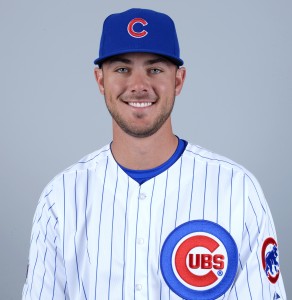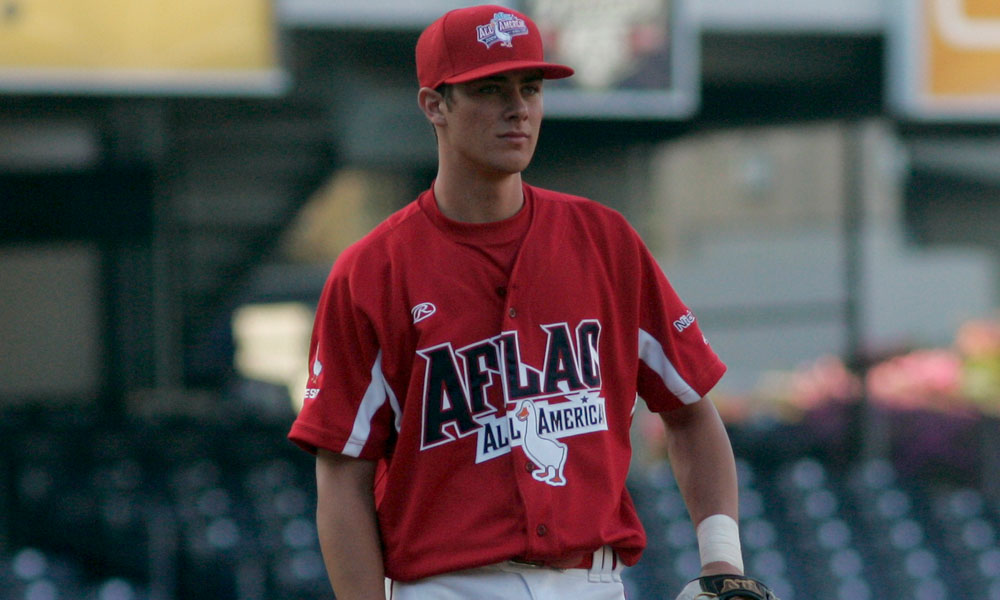Feature Photo: Kris Bryant, 3B, Chicago Cubs (Photo by Perfect Game)
 If you’ve read the earlier installments of the PG in the Pros series, you’ve noticed that this scout likes using comparisons between players to help paint a complete picture of a player, and to give his background some color and perspective. There is no reason to stop doing that with 2015 National League Rookie of the Year Kris Bryant of the Chicago Cubs.
If you’ve read the earlier installments of the PG in the Pros series, you’ve noticed that this scout likes using comparisons between players to help paint a complete picture of a player, and to give his background some color and perspective. There is no reason to stop doing that with 2015 National League Rookie of the Year Kris Bryant of the Chicago Cubs.
The first time I saw Bryant play was as a 17-year-old at the 2009 Perfect Game National Showcase in the Metrodome in Minneapolis. He was listed at 6’5″ and 205 pounds, with extra long arms and legs. His run and throw tools were playable for a big athlete; he ran the 60 in 7.00 seconds, with a smooth stride underway. He threw 87 mph during infield drills. The defensive notes from the event read, in part, “Will have to work hard to become adequate at the corner infield position, 35-40 present arm strength. Left field is another possibility.”

Kris Bryant, 3B, Cubs (Photo by Ron Vesely/MLB Photos via Getty Images)
Bryant’s raw bat speed in 2009 wasn’t eye opening, either. His swing was very loose and low effort, so it might have been a bit deceptive due to the smoothness, but it wasn’t bat speed that was going to make you step back and utter a “wow” to yourself. He did show an ability to take pitches and to adjust his swing approach with two strikes, which is noteworthy both in a taller power hitter, and for a showcase environment.
What was most impressive, though, was what those long levers and easy swing did to a baseball. Bryant could hit the ball as high as any high school player I ever remember seeing play. Even against BP pitchers throwing 52 to 55 mph, he could hit balls that just stayed up in the air and hung there far longer than a normal player.
If you’re not accustomed to listening to scout banter during a game, you might find it strange that scouts are tossing around numbers to each other behind the backstop after a player hits a pop-up or fly ball. It’s just an out, right? We probably didn’t even get a running time. What scouts are timing is the time the ball stayed in the air, with corollary being that the higher in the air the hitter can hit the ball, even on a pop-up to shortstop, the more bat speed and power potential he has.
If a high school player can get a hang time above the 6.2 to 6.3 second range, he’s showing real bat speed. If you register 6.6 to 6.7, that’s some serious lift. To my knowledge, no present Perfect Game scout, myself included, has ever clocked a 7.0+ hang time on a high school hitter.
I don’t recall getting a stopwatch on Bryant at any time, nor are there any notes in the PG database with any hang times on him. But I have no doubt Bryant was very capable of putting the ball in the air for 7.1 to 7.2 seconds, and he probably did so with regularity. His leverage at contact was outstanding and he imparted such backspin on the ball that it fought gravity all the way.
Which brings up to the comparison. The first line of my notes from that National, written during batting practice, read, “+ long levers, tall stance, Kingman look, big-time lift…”
I have an unusual history with Dave Kingman, the 6’6” slugger who was equally well known for his 442 home runs, his then-prodigious strikeout totals, and his unfailing ability to wear out his welcome in very short order with any team. Kingman made his big league debut with the San Francisco Giants on July 30, 1971, as a pinch-hitter. On July 31, 1971, nine-year-old David Rawnsley saw his first major league game, which just happened to be the Pittsburgh Pirates visiting Kingman’s Giants at always-chilly Candlestick Park.
Kingman came up to pinch-hit in that game, too, as part of a double switch, and doubled home Ken Henderson for his first big league hit and RBI. His next time up to the plate he smashed a grand slam, lifting the Giants to a 15-11 win. It was an awesome first game for me, and a pretty good game for Kingman, too, even if it wasn’t quite his first game.
The thing that stood out to me as a youngster about Kingman was that he hit pop-ups that seemed to simply stay in the air. He hit pop-ups that big league infielders dreaded to see starting to fall in their direction. He hit pop-ups that you had to strain your neck to find from the stands. If someone today told me that Kingman hit pop-ups with 9-10 seconds of hang time, I wouldn’t doubt it for a second.
So it was only natural when Bryant started hitting moon shots at the Metrodome that left us wondering about whether the roof was high enough (some did land deep in the left field seats as well) that I think of my first game and Kingman.
Bryant enjoyed a very successful high school career, hitting .418 as a four-year starter and blasting 47 home runs for Bonanza High School in Las Vegas. He was talked about among the elite power hitters in the 2010 MLB Draft, but scouts were left a bit wanting that spring by Bryant’s overall energy and performance. Perfect Game had him ranked 38th in the high school class rankings leading up to the draft. Bryant was also a top student with a GPA well above the 4.0 mark and it was a foregone conclusion going into the draft that he would be going to the University of San Diego. Still, the Toronto Blue Jays made him an 18th round draft pick.
Bryant’s first two years at USD were very solid. He hit .365-9-36 as a freshman and even stole 18 bases. He followed that up with a .366-14-57 sophomore season, walking 39 times against only 38 strikeouts in over 250 PAs.
Two things should be noted at this point. The first is that power was a virtual non-factor in college baseball going into the 2013 season. Changes in the metal bats had made it virtually impossible to drive the ball with any carry and distance. Some teams had hitters use wood bats in practice just so they could “feel” what it was like to hit a ball hard. The second is if there is a college ballpark in the United States that a right-handed hitter can put up impressive home run numbers under any circumstances, it is USD’s Cunningham Field. The outfield measures 312 feet down the left field line and 391 feet to center field, and it plays shorter than that. Put the ball in the air and it has a chance to fly.
And that is just what Bryant did as a junior, despite using bats that bordered on being a scandal in and of themselves. He hit 31 home runs in 62 games (.329-31-62) and pitchers basically stopped throwing to him, granting him 66 walks. His home run numbers were so out of proportion to what was happening around the rest of college baseball that by the end of the season, he had out-homered 223 of the 296 Division I teams all by himself.
The 2013 MLB Draft had three players that were seen as the cream of that year’s crop. Bryant was obviously one, and he was joined by Stanford senior Mark Appel, who had turned down the Pirates offer after being selected with the eighth overall pick in the 2012 MLB Draft, and Oklahoma right-hander Jonathan Gray, who spent his spring season touching triple digits and throwing low-90’s sliders for strikes.
The Houston Astros, in a pick as infamous as their 2012 selection of Carlos Correa was brilliant, choose Appel with the first overall pick. The Cubs, who in retrospect clearly had begun their drive to collect as much position talent as possible, picked Bryant second, and Gray went third to the Colorado Rockies. Bryant signed a few days before the deadline for a $6.7 million signing bonus.
Bryant’s career path is obviously more promising at present than the sum of Kingman’s career, although it is impossible to scoff at Kingman’s 442 career home runs. It was a very good comparison at the time, however. And one can’t help but noting that Kingman’s career year – by a wide margin – came in 1979, when he hit .288-48-115, played in the All-Star Game, and finished 11th in the Most Valuable Player voting. Notably, he did that as a member of the Cubs.


